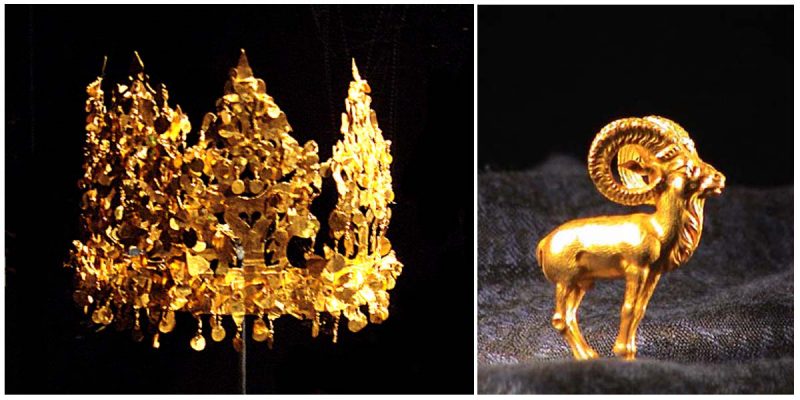ټول حقوق د منډيګک بنسټ سره محفوظ دي

Bactrian gold provides an elusive and fascinating look at the ancient culture of what is now Afghanistan. Tillya Tepe (translated literally as “Golden Hill”) is an archaeological site in the northern Afghan province of Jowzjan near Sheberghan. It is the place where the Bactrian gold was first excavated by the Russian archaeologist Viktor Sarianidi in 1978.
Sariandini and his Soviet-Afghan team unearthed 21,000 pieces of gold in six burial chambers containing five women and one man within Tillya Tepe, dated to around the 1st century BCE.

Crown, Tillya Tepe, Tomb VI, Second quarter of the 1st century A.D. Photo Credit

Belt from Tillia Tepe, with depictions of Dionysus riding a lion. Photo Credit
The hoard includes necklaces set with semi-precious stones, medallions, belts, and a crown. The hoard went missing during the war until it was “rediscovered” and first brought to public attention again in 2003. The Bactrian gold would eventually be kept in a new museum in Kabul. The hoard had belonged to the Yuezhi royal dynasty and it lay undisturbed for two millennia. Rich Kushan nomads were buried in the six chambers around the time of Christ.
In one of the tombs, a silver coin was found from the reigns of the Parthian king Mithridates II, who ruled from 123 to 88 BCE. The coin was held in the hand of the dead woman in Tomb III. In Tomb VI, an imitation gold coin of King Gotarzes I was found in the left hand of the corpse. Because the coin was made of gold, it is believed that it was made for prestige purposes.

Ram figurine from the Bactrian treasure.

Amorini riding on fish, Tillia tepe. Tomb II. Photo Credit
In Tomb IV, the resting place of the male warrior, a Buddhist gold coin from India was found. It depicts a lion with a nandipada, with the Kharoshthi legend “The lion who dispelled fear”. On the obverse, there is a man wearing only a Hellenistic chlamys and a petasus hat.
Some archaeologists believe that this may be an early representation of Buddha. A few Chinese artifacts were also found and this seems to be a testimony to the riches of cultural influences in the area of Bactria at that time.

Men in arm, wearing Greek uniforms. Photo Credit
The hoard was thought to have been lost at some point in the 1990s and in 2003 it was found in secret vaults under the central bank building in Kabul. The last Communist president of Afghanistan, Mohammad Najibullah, had ordered the hoard to be moved to an underground vault at the Central Bank of Afghanistan in Kabul. Only five trusted individuals had keys to the vault.

Sheath for three knives, Tillya Tepe, Tomb IV, Second quarter of the 1st century A.D. Photo Credit
The names of these individuals were purposefully unknown, which made it harder for the new government to open the vault in 2003.
When the keyholders were successfully assembled, the vault was opened and the collection was cataloged by National Geographic, which recorded more than 22,000 objects. In an agreement with France, the Afghan government evaluated the collection and displayed in internationally in an exhibition, with the cooperation of several prominent museums and the National Geographic Society.

